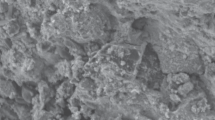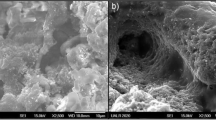Abstract
This study presents an attempt to solve two serious environmental problems: the generation of toxic effluents and solid waste disposal. The work proposes recycling cigarette filters with the purpose of degrading reactive dyes, which are used in the textile industry. Filters of smuggled cigarettes were recycled through Fe3+ immobilization on their surface. The material obtained was characterized through Fourier transform infrared spectroscopy (FTIR), atomic absorption spectroscopy (AAS), scanning electron microscopy–energy-dispersive spectroscopy (SEM-EDS), and ultraviolet–visible spectroscopy (UV–vis). The factorial design revealed that the most suitable conditions for the degradation of Reactive Black 5 dye were obtained by using 1 g of material at pH 3.0 in a 100 mg L−1 hydrogen peroxide solution. The material showed excellent performance in the Reactive Black 5 dye degradation process; in 60 min, 99.09 % dye was removed. At pH 7.0, the dye degradation was 72.67 %, indicating that the material prepared can be used at pH values greater than 3.0 without the occurrence of hydrated Fe3+ oxide precipitation. Furthermore, the material showed no loss of catalytic activity after three degradation studies.







Similar content being viewed by others
References
Ayodele OB, Lim JK, Hameed BH (2012) Degradation of phenol in photo-Fenton process by phosphoric acid modified kaolin supported ferric-oxalate catalyst: optimization and kinetic modeling. Chem Eng J 197:181–192. doi:10.1016/j.cej.2012.04.053
Cerqueira DA, Filho GR, Carvalho RA, Valente AJM (2010) Characterization of cellulose acetate obtained from the bagasse of cane sugar by 1 H-NMR.). Polim: Cienc Tecnol 20:85–91. doi:10.1590/S0104-14282010005000017
Cervantes TNM, Zaia DAM, Santana HS (2009) Study on heterogeneous photocatalysis Ti/TiO2 in colours synthetic discoloration. Quim Nov. 32:2423–2428. doi:10.1590/S0100-40422009000900035
Chong MN, Cho YJ, Poh PE, Jin B (2015) Evaluation of Titanium dioxide photocatalytic technology for the treatment of reactive Black 5 dye in synthetic and real greywater. J Cleaner Prod 89:196–202. doi:10.1016/j.jclepro.2014.11.014
Czayka M, Fisch M (2012) Effects of electron beam irradiation of cellulose acetate cigarette filters. Radiat Phys Chem 81:874–878. doi:10.1016/j.radphyschem.2012.03.003
Dias FF, Oliveira AAS, Arcanjo AP, Moura FCC (2016) Residue-based iron catalyst for the degradation of textile dye via heterogeneous photo-Fenton. Appl Catal B: Environ 186:136–142. doi:10.1016/j.apcatb.2015.12.049
Doumic LL, Soares PA, Ayude MA, Cassanello M, Boaventura RAR, Vilar VJP (2015) Enhancement of a solar photo-Fenton reaction by using ferrioxalate complexes for the treatment of a synthetic cotton-textile dyeing wastewater. Chem Eng J 277:86–96. doi:10.1016/j.cej.2015.04.074
Hall MS, Strarov VM, Lloyd DR (1997) Reverse osmosis of multicomponent electrolyte solutions. Part 1: theoretical development. J Mem Sci 128:23–37
Ignachewski F, Fujiwara ST, Cótica LF, Carneiro LM, Tauchert E, Peralta-Zamora P (2010) Degradation of reactive dyes by photo-Fenton process using Fe3+ immobilized in molecular sieve 4A. Quim Nov. 33:1640–1645. doi:10.1590/S0100-40422010000800004
Kosmulski M (2011) The pH-dependent surface charging and points of zero charge: V. Update. J Colloid Interface Sci 353:1–15. doi:10.1016/j.jcis.2010.08.023
Lan H, Wang A, Liu R, Liu H, Qu J (2015) Heterogeneous photo-Fenton degradation of acid red B over Fe2O3 supported on activated carbon fiber. J Hazard Mater 285:167–172. doi:10.1016/j.jhazmat.2014.10.057
Lee SJ, Altaner C, Puls J, Saake B (2003) Determination of the substituent distribution along cellulose acetate chains as revealed by enzymatic and chemical methods. Carbohydr Polym 54:353–362. doi:10.1016/S0144-8617(03)00189-9
Li H, Li Y, Xianga L, Huanga Q, Qiua J, Zhanga H, Sivaiah MV, Baronb F, Barrault J, Petit S, Valange S (2015) Heterogeneous photo-Fenton decolorization of Orange II over Al-pillared Fe-smectite: response surface approach, degradation pathway, and toxicity evaluation. J Hazard Mater 287:32–41. doi:10.1016/j.jhazmat.2015.01.023
Liu R, Chiu HM, Shiau C, Yeh RY, Hung Y (2007) Degradation and sludge production of textile dyes by Fenton and photo-Fenton processes. Dyes Pigm 73:1–6. doi:10.1016/j.dyepig.2005.10.002
Machulek A, Oliveira SC, Osugi ME et al (2013) Application of different advanced oxidation processes for the degradation of organic pollutants. Environmental Sciences Organic Pollutants - Monitoring, Risk and Treatment 6:141–166. doi:10.5772/53188
Muxel AA, Gimenez SMN, ALMEIDA FAS, Alfaya RVS, Alfaya AAS (2011) Cotton fiber/ZrO2, a new material for adsorption of Cr(VI) ions in water. Clean: Soil, Air, Water 39:289–295. doi:10.1002/clen.201000165
Nogueira RFP, Trovó AG, Silva MRA, Villa RD (2007) Fundamentals and environmental applications of Fenton and photo-Fenton process. Quim Nov. 30:400–408. doi:10.1590/S0100-40422007000200030
Oliveira MC, Nogueira RFP, Neto JAG, Jardim WF, Rohwedder JJR (2001) Flow injection spectrophotometric system for hydrogen peroxide monitoring in photo-Fenton degradation processes. Quim Nov. 24:188–190. doi:10.1590/S0100-40422001000200007
Pereira WS, Freire RS (2005) Ferro zero: iron zero: a new approach for the treatment of waters contaminated with organic pollutants compounds. Quim Nov. 28:130–136. doi:10.1590/S0100-40422005000100022
Rangabhashiyam S, Anu N, Selvaraju N (2013) Sequestration of dye from textile industry wastewater using agricultural waste products as adsorbents. J Environ Chem Eng 1:629–641. doi:10.1016/j.jece.2013.07.014
Ribeiro AR, Nunes OC, Pereira MF, Silva AF (2015) An overview on the advanced oxidation processes applied for the treatment of water pollutants defined in the recently launched Directive. Environ Int 75:33–51. doi:10.1016/j.envint.2014.10.027
Ribeiro K, Andrade TM, Fujiwara ST (2016) Preparation and application of cellulose acetate/Fe films in the degradation of Reactive Black 5 dye through photo-Fenton reaction. Environ. Technol. In press. doi:10.1080/09593330.2015.1127290
Sherman DM, Waite TD (1985) Electronic spectra of Fe3+ oxides and oxide hydroxides in the near IR to near UV. Am Min 70:1262–1269
Silva CP, Voigt CL, Campos SX (2014) Determination of metal ions in contraband cigarettes in Brazil. Rev Virtual Quim 6:1249–1259. doi:10.5935/1984-6835.20140082
Soltani SM, Yazdi SK, Hosseini S, Gargari MK (2014) Effect of nitric acid modification on porous characteristics of mesoporous char synthesized from the pyrolysis of used cigarette filters. J Environ Chem Eng 2:1301–1308. doi:10.1016/j.jece.2014.04.005
Souza KV, Peralta-Zamora P, Zawadzki SF (2008) Immobilization of iron (II) in alginate matrix and its use in textile dye degradation by Fenton processes. Quim Nov. 31:1145–1149. doi:10.1590/S0100-40422008000500041
Taketa LY, Ignachewski I, Villalba JC, Anaissi FJ, Fujiwara ST (2015) Phenol degradation using the mixed material clay/Fe immobilized on glass slides. Environ Sci Pollut Res Int 22:894–902. doi:10.1007/s11356-014-3239-3
Tehrani-Bagha AR, Menger FM (2010) Degradation of a persistent organic dye from colored textile wastewater by ozonation. Desalination 260:34–38. doi:10.1016/j.desal.2010.05.004
Tian H, Gao J, Hao J, Lu L, Zhu C, Qiu P (2013) Atmospheric pollution problems and control proposals associated with solid waste management in China: a review. J Hazard Mater 252–253:142–154. doi:10.1016/j.jhazmat.2013.02.013
Vasconcelos VM, Ribeiro FL, Migliorini FL, Alves SA, Steter JR, Baldan MR, Ferreira NG, Lanza MRV (2015) Electrochemical removal of Reactive Black 5 azo dye using non-commercial boron-doped diamond film anodes. Electrochim Acta 178:484–493. doi:10.1016/j.electacta.2015.07.133
Wang N, Zheng T, Zhang G, Wang P (2016) A review on Fenton-like processes for organic wastewater treatment. J Environ Chem Eng 4:762–787. doi:10.1016/j.jece.2015.12.016
World Health Organization (2015) Tobacco. Publishing who.int. http://www.who.int/mediacentre/factsheets/fs339/en/. Accessed 27 Nov 2015 and http://www.who.int/tobacco/surveillance/gats_factsheet_brazil.pdf. Accessed 27 Nov 2015.
Xiao D, Hu J, Zhang M, Li M, Wang G, Yao H (2004) Synthesis and characterization of camphorsulfonyl acetate of cellulose. Carbohydr Res 339:1925–1931. doi:10.1016/j.carres.2004.06.009
Zanella G, Sharf M, Vieira GA, Peralta-Zamora P (2010) Treatment of textile dyeing baths by photo-Fenton processes and evaluation of the reuse potentiality. Quim Nov. 33:1039–1043. doi:10.1590/S0100-40422010000500006
Zeng Z, Zou H, Li X, Arowo M, Sun B, Chen J, Chu G (2013) Degradation of phenol by ozone in the presence of Fenton reagent. Chem Eng J 229:404–411. doi:10.1016/j.cej.2013.06.018
Acknowledgments
LPG is indebted to CAPES for the fellowship and PJC is indebted to PET Química/UEPG–CAPES for the fellowship. STF is indebted to CAPES, Fundação Araucária, and CNPq for financial support. The authors are also indebted to CLABMU/UEPG for AAS, FTIR, SEM-EDS analysis and the Internal Revenue Service for providing of smuggled cigarettes.
Author information
Authors and Affiliations
Corresponding author
Additional information
Responsible editor: Philippe Garrigues
Rights and permissions
About this article
Cite this article
Glugoski, L.P., de Jesus Cubas, P. & Fujiwara, S.T. Reactive Black 5 dye degradation using filters of smuggled cigarette modified with Fe3+ . Environ Sci Pollut Res 24, 6143–6150 (2017). https://doi.org/10.1007/s11356-016-6820-0
Received:
Accepted:
Published:
Issue Date:
DOI: https://doi.org/10.1007/s11356-016-6820-0




